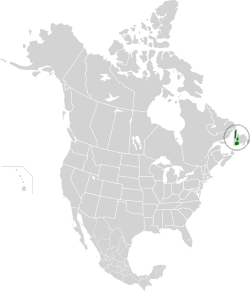Newfoundland Highland forests
The Newfoundland Highland forests are an ecoregion located on Newfoundland, Canada.[1] Part of the Taiga, the total area of the region is 4,031,999 acres (1,631,692 hectares).[2]
| Newfoundland Highland forests | |
|---|---|
.jpg) Highland forests of the Long Range Mountains in Gros Morne National Park | |
 | |
| Ecology | |
| Realm | Nearctic |
| Biome | Canadian boreal forest |
| Borders | Eastern Canadian forests |
| Geography | |
| Area | 486,918 km2 (188,000 sq mi) |
| Country | Canada |
| Provinces | Newfoundland and Labrador |
Terrain
The terrain of this region is mostly between 300 and 700 meters above sea level.[3] It is characterized by steep, rugged Palaeozoic and Precambrian rock, commonly bare or ridged.[1]
Climate
The winters are snowy and cold, and the summers are cool. The region receives between 1,000 and 1,400 millimeters mean annual precipitation.[1]
Mean annual temperature: 4°C Mean summer temperature range: 11.5°C to 12°C Mean winter temperature range: -3.5°C to -4°C.
| Type | Units | Jan | Feb | Mar | Apr | May | Jun | Jul | Aug | Sep | Oct | Nov | Dec | Period |
|---|---|---|---|---|---|---|---|---|---|---|---|---|---|---|
| Min Temp | F° | 10.2 | 7.8 | 14.9 | 26.4 | 34.7 | 43.6 | 51.7 | 51.6 | 44.9 | 35.8 | 27.2 | 18.3 | 1991–2009 |
| Mean Temp | F° | 17.1 | 15.4 | 22.4 | 33.8 | 43.4 | 52.9 | 60.3 | 59.7 | 51.9 | 41.6 | 32.4 | 23.3 | 1974–2009 |
| Max Temp | F° | 24.9 | 24.1 | 30.9 | 40.9 | 52.4 | 62.6 | 69.7 | 69 | 60.8 | 48.8 | 38.8 | 30.5 | 1994–2009 |
| Frost | Days | 31 | 28.2 | 31 | 30 | 28.3 | 14.9 | 1.7 | 3.4 | 11 | 27.9 | 30 | 31 | 1901–2009 |
| Wet | Days | 24.2 | 17.5 | 15.2 | 12.5 | 13.9 | 13.8 | 13.8 | 13.9 | 17.5 | 19 | 20.4 | 23.7 | 1901–2009 |
| Precipitation | in | 5.3 | 3.6 | 3.3 | 2.7 | 2.9 | 3.6 | 3.8 | 4.1 | 4.2 | 4.9 | 5 | 5 | 1901–2009 |
Flora and fauna
The region contains boreal forests with dwarf black spruce (Picea mariana) and balsam fir (Abies balsamea), dwarf kalmia (Kalmia polifolia), and various mosses. Various mixed evergreen and deciduous shrubs can be found in exposed areas.
The Arctic hare (Lepus arcticus) is found in this region. It is their southernmost limit to their range.[3]
Other species include:
- Canada goose (Branta canadensis)
- Great horned owl (Bubo virginianus)
- Brown-headed cowbird (Molothrus ater)
- Snowshoe hare (Lepus americanus)
- Caribou (Rangifer tarandus)
- Red fox (Vulpes vulpes)
- Newfoundland pine marten (Martes americana atrata)
Conservation
The region is threatened by an increase in harvest of wood for lumber and the pulp and paper industry. Higher elevations are mostly threatened by mining interests and granite quarrying. Further threats come from high all-terrain vehicle traffic, which affect some areas.[1]
80 to 90 percent of the region is considered to be intact. Large areas of the region are protected. These are:
- Gros Morne National Park: Comprising upper elevations, and located in western Newfoundland, this area contains 1,942 km2. of protected land.
- King George IV Ecological Reserve: Also located in western Newfoundland, this area contains 19 km2 of protected land.[5]
- Barachois Pond Provincial Park: Located in southwestern Newfoundland, this protected area is 34.97 km2.[6]
See also
References
- "Newfoundland Highland forests". Eoearth.org. Retrieved 2012-08-10.
- "Ecoregion : Newfoundland Highland forests". Global Species. Retrieved 2012-08-10.
- World Wildlife Fund, ed. (2001). "Newfoundland Highland forests". WildWorld Ecoregion Profile. National Geographic Society. Archived from the original on 2010-03-08. Retrieved 2012-08-10.
- "Climate Data for Latitude 49.25 Longitude -57.75". Global Species. 2011-07-28. Retrieved 2012-08-10.
- "King George IV Ecological Reserve". Department of Environment and Climate Change. Retrieved 2017-04-03.
- Terrestrial ecoregions of North America: a conservation assessment, Taylor H. Ricketts, p.379